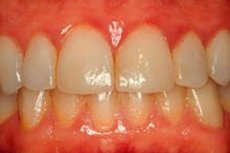Medical expert of the article
New publications
Chronic simple marginal gingivitis
Last reviewed: 29.06.2025

All iLive content is medically reviewed or fact checked to ensure as much factual accuracy as possible.
We have strict sourcing guidelines and only link to reputable media sites, academic research institutions and, whenever possible, medically peer reviewed studies. Note that the numbers in parentheses ([1], [2], etc.) are clickable links to these studies.
If you feel that any of our content is inaccurate, out-of-date, or otherwise questionable, please select it and press Ctrl + Enter.

The gingival margin surrounding the marginal areas of the teeth that is not attached to the periosteum is known as marginal gingiva (from Latin margo - edge, border). And chronic simple marginal gingivitis is a long-term inflammatory process affecting the tissues of the unattached (free) edge of the gingiva. [1]
Epidemiology
According to some reports, gingivitis affects more than 65% of adults and up to 80% of children, but cases of chronic gingivitis of the gingival margin are not separately counted.
Causes of the chronic gingivitis
First, what is the marginal gingiva (marginalis gingivae)? It is the edge of the gingiva not connected to the periosteum, separated from the adjacent attached gingiva (coniuncta gingivae) by a gap or groove at the base of the tooth on the outer side - the gingival sulcus. Thus, the marginal gingiva is the boundary between the connective neorhoving epithelium of this sulcus (containing type I and III collagen fibers) and the mucous epithelium of the rest of the gingiva and the oral cavity. The gingival margin is mobile, but is adjacent to the tooth surface by the basal lamina and intercellular hemidesmosomes of the epithelial tissue, supporting the attachment of the soft tissues of the gingiva to the hard tissues of the tooth.
The main cause of inflammation of the gingival margin epithelium is related to the invasion of bacterial infection by spreading it from bacterial biofilm - plaque on teeth.
If plaque formed by bacteria builds up over time, the free edge of the gum can become inflamed. [2]
Also see. - gum Inflammation
Risk factors
Risk factors for developing simple marginal gingivitis in its chronic form include:
- Poor oral hygiene;
- A state of immunosuppression of any etiology;
- Abuse of sweets or starchy foods;
- Smoking;
- Dry mouth;
- Endocrine disorders, such as diabetes;
- Chemotherapy for cancer;
- Prolonged use of oral contraceptives, steroids, anticonvulsants, anti-ischemic drugs of the group of calcium channel blockers.
In addition, inflammation of the gingival margin and the entire gingiva is susceptible to children with anomalies of the dentoalveolar system, in particular, mandibular prognathism - mesial bite, in the presence of kostmann syndrome or hereditary keratoderma Papillon-Lefèvre. And among the diseases that provoke gingivitis in adults, note agranulocytosis and hormonally active pancreatic tumors producing the peptide hormone glucagon. [3]
Pathogenesis
The human oral microbiota consists of several hundred different types of bacteria. And the pathogenesis of simple marginal gingivitis is due to the induction of pro-inflammatory cytokines, protective polymorphonuclear leukocytes and immunoglobulins (IgG) in response to enzymes, toxins, chemotactic agents and antigens produced by bacteria that penetrate tissues by diffusion. As a result, an inflammatory response develops.
For example, the bacteria Streptococcus mutans and Actinobacteria, which are constantly present in the oral cavity, break down sucrose with their enzymes and release lactic acid, changing the pH of saliva, creating conditions for the activation of growth of other microorganisms of the obligate microflora of the oral cavity, for example, Fusobacterium nucleatum, which with the help of its enzyme breaks down the phospholipids of the cell membranes of the mucous epithelium.
And enzymes of the obligate bacteroid Tannerella forsythia cause degradation of host glycosaminoglycans (mucopolysaccharides), including hyaluronic acid, which is part of the intercellular matrix of the gingival epithelium.
Attaching to protein molecules of epithelial cells and intercellular matrix of gingival tissues, obligate oral spirochetes Treponema denticola exhibit their cytotoxic action, disrupting the structure of cell membranes. Similarly, gram-negative bacilliform anaerobic bacterium Porphyromonas gingivalis penetrates into gingival epithelial cells.
Symptoms of the chronic gingivitis
The very first signs of marginal gingivitis are redness and swelling (swelling) of the gingival margin.
Simultaneously or a little later, symptoms appear in the form of bleeding gums and halitosis (unpleasant odor from the mouth). At the same time, gum soreness is quite rare and occurs later in life.
Complications and consequences
The chronic inflammatory process of the marginalis gingivae may not only lead to an ulcerative-necrotic form of gingivitis, but may also progress to periodontitis.
Complications such as the development of submandibular lymphadenitis and periodontitis affecting the soft and bony tissues - with the exposure of part of the tooth roots and the threat of their loss - are also possible.
Diagnostics of the chronic gingivitis
Diagnosis of any type of gingivitis is made by examining the oral cavity - inspecting the teeth and gums for plaque and signs of inflammation.
Differential diagnosis
The differential diagnosis includes other types of gingivitis as well as periodontitis and periodontitis.
Who to contact?
Treatment of the chronic gingivitis
How to treat chronic simple marginal gingivitis and what means - including antibacterial drugs, antiseptics, home methods (rinses with baking soda, propolis, decoctions of medicinal plants) - are used, detailed in the publications:
- Treatment of gum inflammation
- Treatment of bleeding gums
- Gum diseases and their treatment
- Inflammation of gums in children: how to treat and relieve inflammation
Also read about some of the medications recommended for gingivitis:
Prevention
The only way to prevent the development of gingivitis is through regular and proper hygienic brushing.
Forecast
Gingivitis of the gum margin is the mildest and most common form of gum disease, which can be treated by seeing a dentist in a timely manner.

